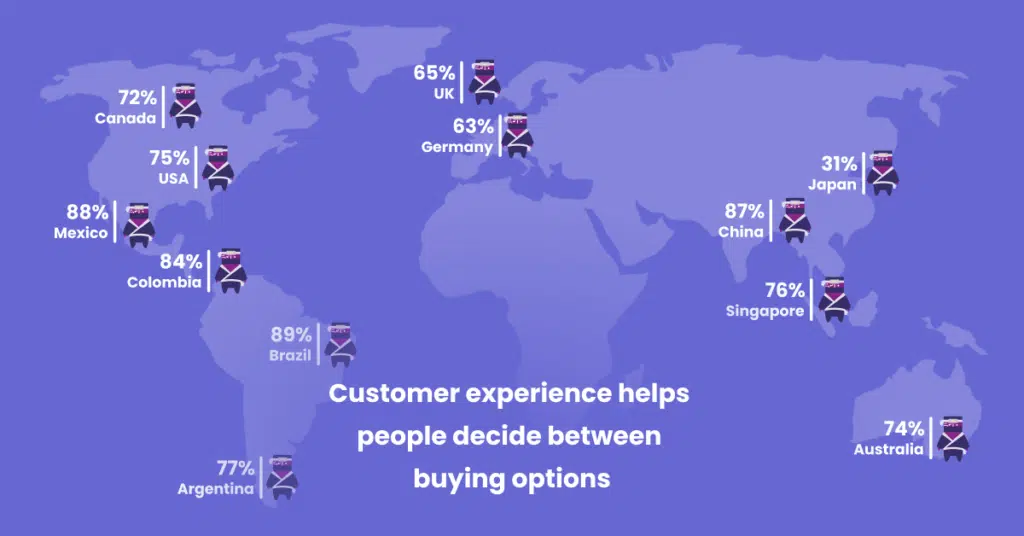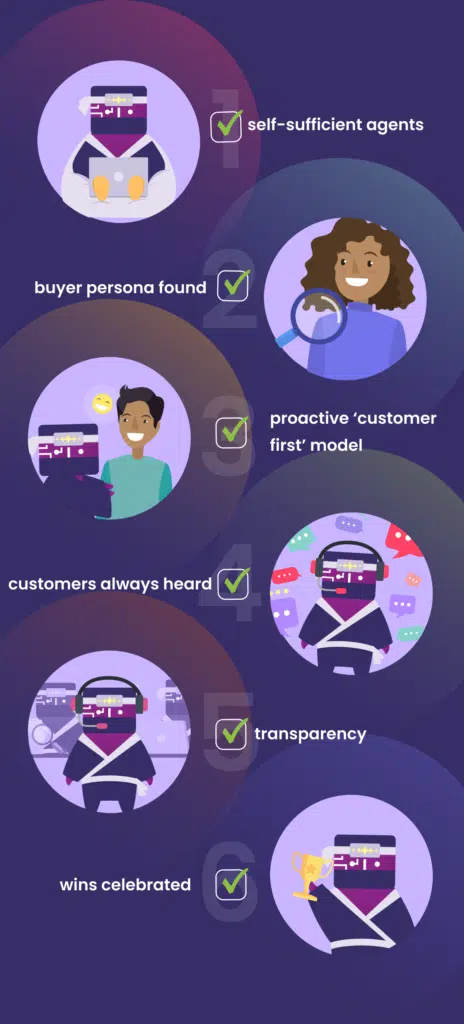What does it mean when a company says they put the customer first? Too often, businesses say this without putting any real thought into it.
They might have a customer service policy where they always try to make the customer happy, but that’s not really what it means.
This article will discuss the true meaning of putting customers first and why it is so vital for businesses.
We will also look at some examples of companies that have succeeded in their customer first service and explore the impact this has had on their bottom line.
What is the meaning of “customer first“?
Putting the customer first means putting the needs of customers above anything else.
When a company puts the customer first, they put the customer at the center of everything they do. They view every decision as having an impact on their consumer and they make sure that they are always considering how each one will affect them. In doing so, customer-centric companies create an atmosphere of trust and good will toward their customers.
Customers are first in the sense that it’s all about them, and satisfying their needs, desires and requirements. It means being fair to them and treating them with respect. Going the extra mile for customers is a natural extension of taking their interests in mind, because you want them to be happy with your products or services.
Building customer-centered culture is the key to surviving in today’s market environment. Businesses should build the voice of their customers into every meeting, review, and decision-making process of the company.
Monitoring what they need through social media and traditional forms like letters or phone calls will help ensure that these needs are met in the future too.
No wonder that Google (search engine), Apple( devices), and Amazon Prime top the list of ‘customer first’ companies — they are all heavily invested in getting feedback from the customer and improving their services based on interactions with customers.
Why is it important to put the customer first?
We can say a lot about this but let’s talk numbers.
According to QualtricsXM, poor customer experiences put $1.9 trillion in consumer spending at risk every year.
Moreover, PwC found that on average, for 73% of customers customer experience is an important factor in their purchasing decisions. However, since only 49% of US customers say companies provide good customer service, there is a lot of space to improve.

Q: When it comes to making purchase decisions, how important is customer experience in choosing between options? Source: PwC
“Customer is always right” is not “customer first”
But does that mean that the customer is always right? Is that what the customer first attitude is all about? Short answer: no.
In recent years, there has been a shift in the way we think about customer service, with a move away from the “customer is always right” approach toward the “customer first” philosophy.
Being a ‘customer first’ team doesn’t mean that you should do whatever the customer wants at any given moment, even if it goes against company policy or ends up hurting your business in the long run. There has to be a point where you draw the line and recognize the fact that the customer is being unreasonable or is just trying to use their advantageous position in the situation.

The idea is that businesses should put the customer’s needs and wants first, but not by neglecting their own employees.
The worst thing that can happen when you are a customer service representative is constantly being insulted by customers and having nowhere to turn for upper management support. Eventually, you will turn on the company.
How to put your customers first?
1. Study the customer

The best way to start putting your customers first is by studying them. Get to know their likes and dislikes, what makes them happy, and what frustrates them.
With a good customer intelligence team or system in place, you can use this information to tailor your customer service accordingly.
Read More: Customer intelligence will build your business — here’s why
2. Continuously train your agents
Continuously train your agents to deliver customer-first service. Teach them the importance of always putting the customer first in every interaction. By instilling this customer-centric mindset in your team, you’ll surely see an uptick in customer satisfaction scores.
But just onboarding agents when they start with the job is far from being enough. One way to ensure that your agents provide the best possible service is to train them continuously. You can help your agents stay up-to-date on the latest information and trends by providing regular training. Additionally, training can help to refresh your agents’ skills and keep them sharp.
One way you can provide that continuous training is by creating Coaching Cards, these handy notes where you can tell agents what they need to improve, why, and how. You can also give them follow-up tasks and deadlines to see improvement fast.
Here’s what they look like in Kaizo.

3. Build proactive customer service teams
Putting clients first should be any business’s top priority. After all, without customers, companies would not exist. That’s why building proactive customer service teams is so important.
Proactive customer service teams are always looking for ways to improve the customer experience. They’re constantly asking themselves how they can make things better for their customers. It could even be as simple as making minor changes to the way they interact with customers or completely rethinking how they do business.
The bottom line is that proactive customer service teams always put their customers’ needs first and reach out to them before problems arise. And that’s something that all businesses should strive for.
Read More: How to build proactive customer service from scratch
4. Harness the power of technology

A great customer first strategy needs great technology to support it. In order to facilitate a culture of “customer first” you need a competitive tool to rely on.
Kaizo boosts productivity and improves customer satisfaction by implementing gamification into the customer support team. The platform provides individual assessments, skill development training for each employee to ensure they are constantly achieving metrics that will help them succeed — all through one easy-to-use system!
Read more: How END. built their best support team ever
Is your company “customer first” yet? Here’s a checklist to help you answer that question.

1. Have self-sufficient customer service representatives
To have excellent customer service, you need to empower your customer service representatives with the tools and autonomy they need to do their job. By empowering your employees, you are putting clients first.
Give representatives freedom to resolve issues as they see fit. Of course, this doesn’t mean that you should be completely hands-off, but it does mean trusting your team to handle problems in a way that is best for the client. When you show that you trust your team, they will be more likely to trust you, ultimately leading to better communication and a more positive work environment overall.
In fact, in our recent survey on agent empowerment we found that 73% of agents want more autonomy in their role.

2. Know your client or buyer persona
To create a customer first business strategy, you must know your target audience and customers. Knowing your buyer persona will allow for policies and guidelines explicitly tailored towards their needs and save money on unnecessary efforts such as marketing strategies or product rollouts.
3. Develop and encourage a proactive customer first model
Building a proactive clients first and quality focus culture means that you need to encourage agents to get out there and reach out to the customers, go that extra mile for better customer experiences. It is about developing leadership skills that will help your agents brainstorm solutions and be creative at all times.
4. Hear your customer
Your customer-first strategy will only be successful when it relies on feedback from your customers.
Customers can provide valuable insight into whether or not they are satisfied with your product or service and proactively tell you what needs to change.
When developing strategies for marketing campaigns, make sure that there is room to survey clients at various points during the process — this way, you will know if your strategy works as intended before anything happens.
5. Be transparent
Unfortunately, there are times when we can’t always provide our customers with the answers they want. That’s why it’s important to explain why you’re unable to do it and what will happen next instead of giving them a plain “I am sorry.”
In a world where everyone seems too busy or stressed out for communication, taking the time to provide all the needed answers is valued more than ever.
6. Celebrate wins
Any good manager will tell you that it’s important to celebrate wins, both big and small.
And when it comes to implementing a customer-first strategy, this is especially true.
Good customer service is often the result of hard work and dedication from a customer-first team so it’s important to acknowledge successes along the way.
This not only helps to motivate employees, but it also shows customers that their satisfaction is a top priority.
In today’s competitive market, great customer service can be the difference between a successful business and one that struggles to survive. By taking the time to celebrate wins, you can ensure that your business is always putting its best foot forward.


